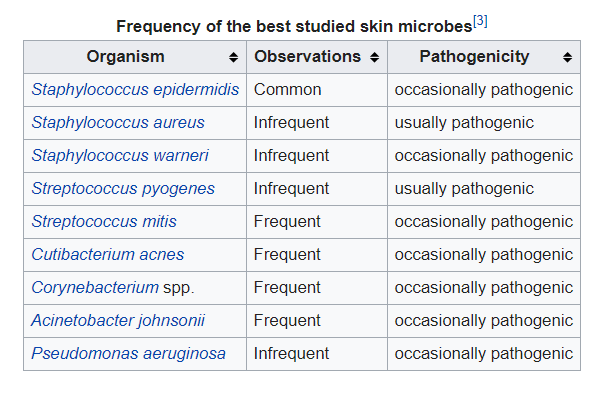Skin Microbiome: Should I Be Protecting Mine?
What is the skin biome, and why do I suddenly see references to this on skincare products?
The term biome refers to the naturally occurring group of living things in a habitat. The skin biome encompasses all of the yeast, bacteria, and mites that commonly live on the skin. What? That’s right; there are a lot of things growing on all of us. Let’s talk about the things that grow on our skin and why it might be useful to protect them.
Bacteria: There are at least hundreds of types of bacteria that live on the skin without causing many problems. This is often called “normal skin flora.” Some species of Staphylococcus, Micrococcus, Diptheroids, Corynebacterium, and more are common components of normal skin flora. In some cases, these “normal” organisms can be pathogenic and cause problems as well.
Yeast: Pityrosporum, aka Malasezzia yeast, is common on the skin, but when it overgrows, it causes Tinea Versicolor.
Mites: Demodex are a mite that primarily live in oily skin areas of the face. For many, these mites are harmless, but they may play a role in skin conditions such as acne, rosacea, and seborrheic dermatitis by causing inflammation. Topical medications, such as Soolantra, are designed to reduce inflammation in rosacea by killing Demodex.
Scientists suggest that the skin biome as a whole performs a few essential roles:
-Protects our skin from unhealthy organisms
-Helps maintain a healthy pH to the skin
-Maintains the skin barrier
-Produces nutrients and skin lipids
Is the skin biome related at all to the gut biome? Researchers now believe there may be a connection, but the exact relationship is still very unclear.
Should I take a pre or probiotic or use skin care products that contain them?
First, let’s clarify:
A Prebiotic is a non-digestible food ingredient that promotes the growth of microorganisms in the gut. It non-selectively increases the growth of both beneficial and harmful microorganisms. In contrast, a Probiotic contains living microorganisms that can provide beneficial growth when used topically or taken orally.
In general, taking an oral probiotic is never a bad idea, but skincare products advertising these claims are not usually effective.
How do I protect my skin biome? Proponents of protecting the skin biome suggest gentle skin cleansing only with a neutral pH and taking an oral probiotic.
Is the skin biome consistent on all parts of the skin? No. When considering skin flora, we have three major areas of the body that tend to grow different microorganisms.
1- Dry body sites include arms, legs, hands and feet, and some areas of the trunk.
2- Moist body sites include the folds – groin, axillae, between toes, and under the breasts.
3-Oily or sebaceous sites – Face, scalp, center chest where lots
of sebum is produced.
Many companies claim their products are designed to protect the biome, including:
-Dove sensitive skin Body Wash
-Mother Dirt – Includes a patented “peacekeeper” bacterial spray that restores the ammonia-oxidizing bacterial (AOB) portion of the skin biome. Crazy as it sounds, some people swear by it. Please note, there are minimal real scientific skin studies on this product or proof that it works. I must admit the whole concept is intriguing. Maybe I’ll do a test of it and let you know. At $50 per bottle, let me be the guinea pig.
What types of products may work against a healthy skin biome?
-Antibacterial soaps
-Preservatives in cleansers
-Aggressive scrubbing
-Swimming pool chemicals
Now, everyone who reads this blog knows I am a big fan of antibacterial soaps for many skin conditions to reduce pathogenic or harmful bacteria. Some preservatives in skincare products are often a necessary evil to reduce spoiling of products. So, everything in moderation. Use an antibacterial when you believe you have been exposed to pathogenic or harmful bacteria. The table below (Wikipedia) demonstrates that normal hand washing without antibacterial ingredients does little to kill bacteria or alter the biome. So, if you are exposed to harmful bacteria, use antibacterial soap.

My conclusions: most of us do not need to be overly concerned about our “skin biome.” It will likely live on and grow on despite our behavior or product choice. Taking a probiotic won’t hurt for the gut and may help the skin as well. Sometimes it is necessary to use an antibacterial soap to prevent spread or to treat harmful bacteria.
If you know someone who may find this article helpful, please share it with them! Follow us on social media this week, and subscribe to our growing YouTube channel!
If you would like to receive these posts in your email inbox, Subscribe to our Site.
|